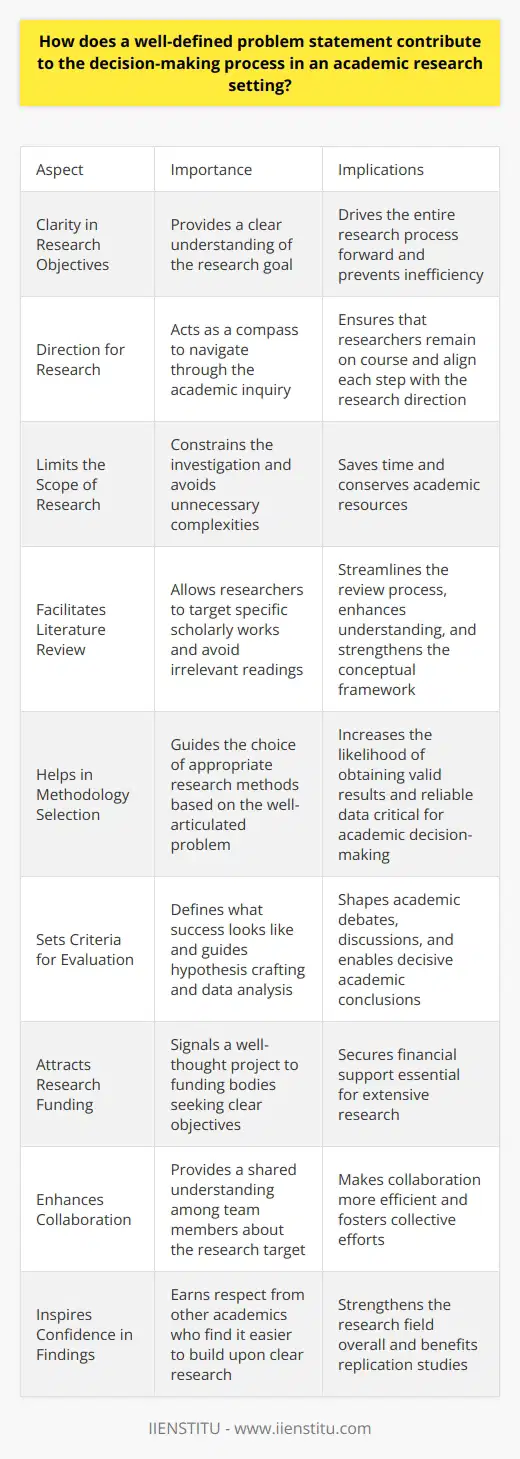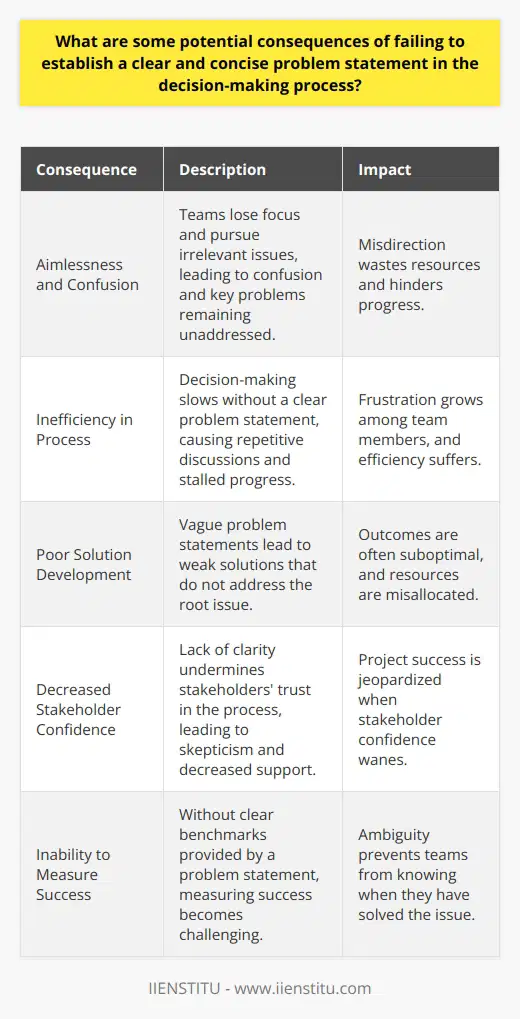
In the realm of decision-making, the clarity with which a challenge is defined can often determine the success of the solutions proposed. Crafting a concise and articulate problem statement is an art and science that sets the foundation for effective analysis and action. This article delves into the quintessence of formulating such a foundation, a task that is central to the realms of research, business strategy, and educational domains, such as during the pursuit of learning problem solving skills.
A well-designed problem statement serves as the compass by which stakeholders can navigate the complexities of a predicament, ensuring that resources and intellectual efforts are directed towards genuinely productive ends. With this in mind, let us explore the underpinnings of what makes a problem statement not just good, but great.
Introduction to the Concept of Problem Statement
Definition and Importance of a Problem Statement
A problem statement is the articulation of an issue that needs to be addressed. This pivotal element provides a succinct explanation of the obstacles that impede objectives from being attained. In the academic sphere, its significance is irrefutable, as it guides researchers to a clear focus on their study's intent and scope. In business, a well-crafted problem statement can be the difference between a successful venture that effectively meets market needs and one that flounders due to a lack of direction. Real-world examples where problem statements are indispensable include the initiation of a research project, where identifying the gap in knowledge is crucial, and the launch of a new product, where understanding the customer's pain points is key.
Effective problem statements are also vital in disciplines such as engineering and technology, where they frame the objectives for development projects. For instance, when an engineer is tasked with improving the energy efficiency of a building, the problem statement must accurately describe the current inefficiencies, potential areas for improvement, and the desired performance outcomes. Similarly, in healthcare, a clear problem statement might underpin efforts to reduce patient wait times, targeting the very heart of what needs amending.
Elements of a Well-Defined Problem Statement
A well-defined problem statement encompasses several key elements: it must be clear, concise, and have a defined scope. These elements eliminate ambiguity and enable stakeholders to grasp the issue quickly. Clarity ensures that all parties have a mutual understanding of the problem. Consistency is equally paramount, as it ensures that the problem is defined in the same way over time, allowing for a stable benchmark against which progress can be measured.
A poorly articulated or vague problem statement can lead to wasted resources, as teams may focus on peripheral issues rather than on the core problem. To avoid such a scenario, one must ensure the problem statement addresses the "5 Ws" – who, what, where, when, and why. To illustrate this, consider the difference between "sales are dropping" and "our Midwest region has seen a 20% decline in sales over the last quarter due to unexpected competitor advancements." The latter clearly outlines the boundaries and causes of the issue, while the former is likely to provoke more questions than solutions.
Crafting a Stealthy Problem Statement
Understanding the Context
Comprehension of the context in which a problem arises is invaluable. It provides the backdrop necessary for appreciating the complexities and nuances of a situation. A robust problem statement should grow from a deep understanding of the environment in which it exists. Ignoring context can result in a superficial or even incorrect definition of the problem, paving the way for ineffective or misdirected solutions.
For example, a problem statement for declining sales in a luxury goods company may differ dramatically if one considers the economic downturn as context compared to a surge in counterfeit goods. The former would entail strategies rooted in economic psychology, while the latter would warrant a legal and brand protection response. Context shapes the problem statement which, in turn, anchors the course of action.
Identifying Problems and Solutions
A delicate balance exists between stating a problem and suggesting a solution within the problem statement. One must take care to clearly identify the issue at hand without presupposing a solution. This premature jump to solutions can narrow the exploration of alternative strategies and may overlook root causes. The process of identifying a problem and its potential solutions begins with observation and inquiry, followed by the distillation of complex information into a precise problem statement.
Take the development of online certificate programs as an example. The problem statement could focus on the needs for professional development opportunities that are accessible and flexible. Therefore, rather than simply resolving to create more programs, the problem could be articulated in terms of addressing the need for convenient, scalable, and quality education. This invites a myriad of potential solutions that may involve technology, pedagogy, or even marketing strategies.
Maintaining Clarity & Precision
Maintaining clarity and precision involves avoiding technical jargon, staying specific to the issue, and avoiding generalizations. The goal is to be both concise and thorough – covering all the necessary aspects without overwhelming the reader with superfluous details. It should be accessible to those with a stake in the outcome, irrespective of their expertise in the subject matter at hand.
Precision can be achieved through iterative revision, ensuring that each word serves a purpose. One helpful tactic is to have various stakeholders review the problem statement and provide feedback—consider it a litmus test of universal clarity. Clarity and precision are hallmarks of a well-crafted problem statement and serve as beacons that guide subsequent problem-solving efforts.
Case Studies of Effective Problem Statements
Case Study 1: Problem Statement in a Research Context
In the context of academic research, an effective problem statement often delineates the boundaries of scholarly inquiry. Consider a case where researchers are investigating the decline in bee populations. A successful problem statement might underscore the specific type of bee affected, the geographic scope of the study, and the timeframe during which the decline was observed. It might also hint at the suspected causes that the research will explore, such as the impact of pesticides or changes in land use.
The strength of this problem statement lies in its ability to focus research efforts, guide methodology, and inform the relevant literature review. The specificity regarding the type of bee, the locality, and the timeframe renders the research manageable, while also pointing toward the most pertinent data for collection and analysis.
Case Study 2: Problem Statement in a Business Context
Within a business framework, an effective problem statement catalyzes strategic planning and operational changes. For instance, a company noticing customer churn might identify through careful analysis that clients are leaving due to suboptimal customer service. A strong problem statement in this scenario would not only quantify the churn rate but would also link it to specific aspects of the customer service experience that fall short, informed by customer feedback and market comparisons.
Highlighted features of such a problem statement might include its basis in customer data, its focus on measurable service elements, and its alignment with overall business objectives. Notably, it paves the way for targeted customer service improvements that have the potential to reduce churn directly.
The Pitfalls to Avoid When Crafting a Problem Statement
Disorganized Thoughts and Lack of Precision
Clustering disorganized thoughts and imprecise language undermine the efficacy of a problem statement. Rather than drawing a direct line from problem to potential investigation, a muddled statement can scatter efforts and dilute focus. To avoid such issues, one must engage in critical thinking, systematically organizing thoughts and ensuring each phrase contributes to a well-defined statement.
Techniques such as mind mapping can aid in structuring thoughts before drafting a problem statement. This visual representation of ideas can highlight connections and focus areas, which then translate into a coherent narrative. Precision is a result of this deliberate organization – it ensures that the problem statement conveys the exact nature and scope of the issue without room for misinterpretation.
Overloading with Data
Data is undeniably central to understanding problems, but overloading a problem statement with data can obfuscate rather than clarify. The aim should be to present the data necessary to comprehend the problem's gravity and scope, not to overwhelm with an exhaustive data set. Striking this balance is a skill that ensures the problem statement remains a useful tool for problem-solving.
To prevent data overload, it's essential to parse out only the most relevant figures that illuminate the problem. For instance, when describing a decline in sales, data on the percentage decrease, affected regions, and product lines might be pertinent, while historical data from several years prior may be extraneous. Careful selection of data points helps maintain the reader's focus on the current problem at hand.
Conclusion: The Power of an Effective Problem Statement
To encapsulate, a well-honed problem statement is much like a compass: it points decision-makers in the direction they need to pursue with assuredness and precision. Whether in the domains of academic research, business strategy, or personal endeavors such as mastering learning problem solving, the capacity to succinctly articulate a problem is indispensable to finding meaningful solutions. It requires the crafting of clear, concise, and issue-specific narratives that are informed by an understanding of context, relevant data, and the absence of predetermined solutions.
The value of investing time in constructing a well-structured problem statement cannot be overstated—it resonates through every subsequent step of the problem-solving process. It calls upon us to embrace an intersection of critical thinking, data analysis, and clear communication. For researchers, professionals, students, and leaders alike, the competencies honed through this exercise are central to success. Let this call-to-action serve as an impetus for all readers to refine their approaches to defining problems, for it is upon the solidity of this foundation that the most elegant solutions are built.
Frequently Asked Questions
What are the key elements that should be included in a well-constructed problem statement for effective decision making?
Key Elements of an Effective Problem Statement
A well-constructed problem statement is vital. It guides decision-making. It also focuses the team. Clarity and conciseness are key. They ensure understanding and enable action.
Define the Problem
Understanding begins with identification. A problem statement should open with a clear problem definition. Define what is not working. Avoid ambiguity. Be specific.
Explain the Context
Describe the problem's environment. Who does the issue affect? What are the boundaries? Context guides relevance. It helps prioritize. Decision-makers gauge impact here.
Articulate the Impact
State the problem's consequences. Use data and facts. How does the issue harm operations? Quantify effects when possible. Convey urgency through impact.
Specify the Goals
Goals counterbalance the problem. They should be clear. Define what resolving the issue looks like. Make the objectives measurable. They guide the solution development.
Identify Requirements and Constraints
List what is necessary for solutions. Include resource needs. Mention time, budget, and technology. Constraints limit the solution space. Acknowledge these boundaries early.
Pose the Problem as a Question
Formulating the issue as a question invites solutions. It should inspire brainstorming. Keep it open-ended. Ensure it leads to multiple approaches.
Incorporating these elements yields a robust problem statement. It aligns stakeholders. It streamlines decision-making processes. Quality decisions demand such a foundation.

How does a well-defined problem statement contribute to the decision-making process in an academic research setting?
Importance of a Well-Defined Problem Statement
Clarity in Research Objectives
A well-defined problem statement is crucial. It provides clarity. Researchers understand the goal clearly. This clarity is fundamental. It drives the entire research process forward. Unclear objectives result in inefficiency. A clear problem statement prevents this.
Direction for Research
It offers direction. A problem statement acts as a compass. Researchers use it to navigate through the academic inquiry. Each research step aligns with this direction. This ensures that researchers remain on course.
Limits the Scope of Research
It limits the scope. Unbounded research can be overwhelming. A narrow problem statement constrains the investigation. Researchers can thereby avoid unnecessary complexities. It saves time. It also conserves academic resources.
Facilitates Literature Review
A precise problem statement aids the literature review. Researchers can target specific scholarly works. They avoid irrelevant readings. It streamlines the review process. This leads to better understanding. It also enhances the conceptual framework.
Helps in Methodology Selection
It informs methodology selection. Researchers deduce appropriate methods from it. A well-articulated problem guides this choice. This increases the likelihood of valid results. Appropriate methods yield reliable data. This data is critical for academic decision-making.
Sets Criteria for Evaluation
A concise problem statement sets evaluation criteria. Researchers know what success looks like. They craft hypotheses based on it. These guide data analysis. This shapes academic debates and discussions. Clear criteria enable decisive academic conclusions.
Attracts Research Funding
It can attract funding. Funding bodies seek clear objectives. A robust problem statement signals a well-thought project. This credibility can secure financial support. Funds are essential for extensive research. Funding bodies favor clearly defined projects.
Enhances Collaboration
It enhances collaboration. Team members gain a shared understanding. Everyone knows the target. Collaboration becomes more efficient. Collective efforts thrive on mutual comprehension.
Inspires Confidence in Findings
It inspires confidence in findings. Other academics respect clear research. They find it easier to build upon. Replication studies benefit. This strengthens the research field overall. Clear problem statements bolster the academic fabric.
Conclusion
In conclusion, a well-defined problem statement is cardinal. It contributes to sound academic decision-making. Its absence can derail a research endeavor. Academics must craft this statement with care. It fosters academic success.

What are some potential consequences of failing to establish a clear and concise problem statement in the decision-making process?
The Importance of a Problem Statement
A clear and concise problem statement is critical. It guides the decision-making process. Without it, numerous negative outcomes can arise. Here are some potential consequences.
Aimlessness and Confusion
Without clarity, teams can lose focus. They may pursue irrelevant issues. This can lead to confusion. Key problems may remain unaddressed. Misdirection wastes resources.
Inefficiency in Process
Decision-making slows without a clear problem statement. Stakeholders may struggle to align. This can cause repetitive discussions. Progress stalls. Frustration grows among team members.
Poor Solution Development
Solutions rely on problem understanding. A vague statement leads to weak solutions. These solutions might not address the root issue. Outcomes are often suboptimal in such cases. Efficiency suffers.
Resource Misallocation
Resources are limited. They require careful allocation. An unclear problem statement can cause misallocation. Teams might over-invest in minor issues. Conversely, they might under-invest in major ones.
Decreased Stakeholder Confidence
Stakeholders need trust in the process. Lack of clarity undermines this trust. They may become skeptical. Their support could wane. This can jeopardize project success.
Inability to Measure Success
Success requires benchmarks. A problem statement provides these. Without one, measuring success is challenging. Teams need to know when they have solved the issue. Ambiguity prevents this.
Increased Risk of Failure
Every decision carries some risk. An unclear problem statement amplifies this. It can lead to compounded errors. Consequently, the risk of failure increases.
In conclusion, the stakes are high. A clear problem statement is indispensable. It is the foundation of effective decision-making. Without it, we invite a multitude of problems.



